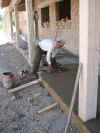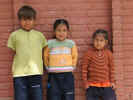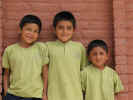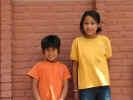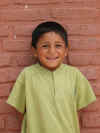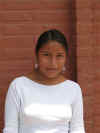welcome to worldwidewachs.com
THIRD TIME'S THE CHARM
ARRIVAL
Two years ago we left our friends and projects in Cochabamba, Bolivia with the promise that we would return. Today we honor that promise.
As we alight from the plane in La Paz, I am suddenly off-kilter, momentarily adrift in time and space. In addition to being at the dizzying altitude of 12,000 feet, there are 3 enormous fir trees dusted with snow, standing just outside the terminal. The ground is 3 inches deep in show and the surrounding craggy mountains are sparkling and glistening white. I am in a time warp and it is Christmas. Only it can’t be – it was yesterday when we left our midwest home in the September heat and humidity.
But it IS for real. LaPaz has had a brief cold snap and a hefty snowfall, and the temperature today is zero degrees Centigrade. Prepared as we are for arrival in sunny, springlike Cochabamba, our 3-hour wait in the frosty, skimpily heated LaPaz airport is a test of fortitude. I wrap my light jacket around me and order a steaming cup of cafe to ward off the growing chill.
At last we board our flight to Cochabamba and the shivering and altitude lightheadedness is over. In the thin, watery early light of morning, the sharp and angular snowy mountains are hazy and slightly faded. These Andean peaks between LaPaz and Cochabamba are 15,000 to 21,000 feet high, and on this short 40-minute flight, we glide barely above them. Cutting it heart-stoppingly close to the last ridge, we suddenly open into the expansive brown bowl of a valley that is Cochabamba, and drop our altitude to 8400 feet in just a few miles.
It is blessedly springtime here. The sun is rich and warming, and the air filled with promise. The screaming purple jacarandas, the orange and purple bougainvilleas, the vibrant golden carnivalito tree, and the paler but regal hibiscus are bursting over walls and fences. The Cochabambinos are bustling around the city in shirtsleeves, and the snow is now just a distant but majestic reminder on the highest peaks surrounding the city. In coming to Cochabamba, we have completed the circle, returned to the place where our hearts have wandered so often during these last two years. Many projects, commitments and loved ones await us.
We are back in the home of Lucy Salazar, in the same accommodations we enjoyed two years ago. There is the well-remembered glorious view of the city from our perch halfway up the mountain, and the same now-famous multi-level bathroom, with its pint-sized angular shower, where only contortionists can get clean. (Jean Carla, the Amizade director, tells us many Amizade volunteers who read the 2003 journal on our website have asked to pass by her home, just to see for themselves this unusual, quirky bathroom.)
The city has not changed much – a new road partway to the airport, a more modern arched bridge on Calle Santa Cruz, some parks with different configurations of flowers or rock walls. Here and there some stores and restaurants and internet cafes have changed hands. But it is the Cochabamba we remember, with its inventive, stunning architecture contrasted against tired, crumbling, ancient walls and buildings; lustrous blossom-filled, meticulously tended residential gardens, yet broken, uneven sidewalks filled with garbage and skeletal homeless dogs; ubiquitous taxis and buses and trufis (large vans) carrying the busy, purposeful citizenry, coming and going from stores and offices and homes with urgency, yet retaining the centered focus on family and friends and quality time with those they love.
It is the same, yet it seems more deserted. There are so many beautiful homes now with no inhabitants. There are abandoned, partly-built office buildings left wondering what will become of them. And there are untended lawns and gardens now gone haywire. Jean Carla and Lucy say the political turmoil and continued poor economy have forced even more Bolivians to move away – to Europe, the U.S. and neighboring Latin American countries. Many of the country’s brightest and most ambitious people feel forced to go elsewhere to provide a livelihood for their families, just when Bolivia needs them the most. (Martie)
CEOLI
CEOLI is a glorious treat for our eyes and hearts. The telemarathon money
received 2 years ago has been used to transform the battered, monotone
classrooms into a rainbow-colored, welcoming complex, as though a giant wave of
color had splashed generously over the campus. There is a new outdoor
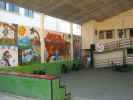 gathering area with 12-foot high murals of handicapped kids having fun in parks,
playgrounds and homes. There are pristine new bathrooms with fixtures that
actually work, and a brand new colorfully painted area for infants. The
vocational jewelry-making and CEOLI card painting classes have their own rooms
now. Equipment or supplies for the baking classes, and sewing/tailoring classes
is still lacking. But they have purchased a specially equipped van for
transportation to and from the center. With very little additional
square-footage in ground space, CEOLI has magically created a wonderful new area
for its kids. And it can now serve 200 young people, up from 120 only two years
ago.
gathering area with 12-foot high murals of handicapped kids having fun in parks,
playgrounds and homes. There are pristine new bathrooms with fixtures that
actually work, and a brand new colorfully painted area for infants. The
vocational jewelry-making and CEOLI card painting classes have their own rooms
now. Equipment or supplies for the baking classes, and sewing/tailoring classes
is still lacking. But they have purchased a specially equipped van for
transportation to and from the center. With very little additional
square-footage in ground space, CEOLI has magically created a wonderful new area
for its kids. And it can now serve 200 young people, up from 120 only two years
ago.
The love and joy that is the heart of CEOLI’s warmth is just as palpable as
ever. Kids with cerebral palsy, Down’s syndrome, musculo-skeletal disorders and
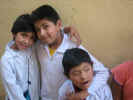 a
variety of other health problems, many of which require wheelchairs, are
laughing and playful. Many of the same teachers and staff – Ronald, Dr.
Cinthia, Gilma, Norma, Daniela – are still there, and their care and love for
the kids is engulfing. This is a true haven for handicapped kids – a place of
deep caring, love, acceptance and hope for the future.
a
variety of other health problems, many of which require wheelchairs, are
laughing and playful. Many of the same teachers and staff – Ronald, Dr.
Cinthia, Gilma, Norma, Daniela – are still there, and their care and love for
the kids is engulfing. This is a true haven for handicapped kids – a place of
deep caring, love, acceptance and hope for the future.
But the warm atmosphere and the bright welcoming building belie the financial struggles CEOLI now has. Because its physical facilities are now so attractive, prospective donors assume monetary help is no longer necessary. Some of the local and even the European organizations that have long supported CEOLI are reducing or withdrawing their funding, in favor of other institutions perceived to have a greater need. A university from Holland, which sent volunteer interns every semester, and raised money for CEOLI services and facilities, is transferring its support to a small center in a rural village about 20 miles away. However, operating expenses at CEOLI are even higher, because they are serving 60 – 70% more handicapped children than 2 years ago. CEOLI struggles ever more desperately to finance medical, therapeutic, counseling, dental and educational services to these mostly poor and neglected young people. It is a sad and worrying undertone to an otherwise joyful and vibrant place.
Over the next two weeks, we go to CEOLI almost daily. Our first job is to
interview and photograph each artist who paints CEOLI cards (hand-painted cards
with vivid colors and traditional Bolivian scenes), then write up short
biographies. We plan to print the bios on small inserts to be included in the
card
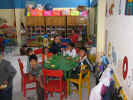 packages for 2006 card sales. At first the young artists are shy and skeptical. Why are
we asking all these questions about them, they wonder? I tell them that so many
people in the U.S. who love their cards want to know about them – how old they
are, what they have studied in school, what their hobbies are, do they have
brothers and sisters? I think it is hard for them to grasp that anyone in the
U.S. has that much interest, and they begin with just the shortest and skimpiest
of answers. But I persist, ask for details, and they gradually open up, their
eyes shine a bit brighter, and their gestures become more active as they share
more about their lives.
packages for 2006 card sales. At first the young artists are shy and skeptical. Why are
we asking all these questions about them, they wonder? I tell them that so many
people in the U.S. who love their cards want to know about them – how old they
are, what they have studied in school, what their hobbies are, do they have
brothers and sisters? I think it is hard for them to grasp that anyone in the
U.S. has that much interest, and they begin with just the shortest and skimpiest
of answers. But I persist, ask for details, and they gradually open up, their
eyes shine a bit brighter, and their gestures become more active as they share
more about their lives.
We meet the handsome, intelligent, curly-haired Jorge, college-educated as an agronomist who had to abandon that job when he became quadriplegic, and who now is trying to earn money to send his young son to school and provide a college education for him. There is the petite and quiet Maria Luz, also quadriplegic due to an accident that killed her husband and baby daughter. She lives in a group home where she can do most of her painting, because it is hard for her to go anywhere outside the home. We meet Limber, German, Maribel and Alejandro – also all quadriplegics. And finally young Leonardo, whose family abandoned him because he is both deaf and mute. No one knows where he is from, or even when he was born.
They love painting, the artists all say. Limber wants to continue studying art in one of the local universities, after he graduates from high school this year at age 24. Alfredo and Jorge want to expand their skills and have Daniela, the art teacher and CEOLI card supervisor, teach them about ceramics painting. Several members of the CEOLI staff tell us that in this last year, there are marked differences in the confidence and esteem of these young artists. They have real jobs and responsibilities now, and somebody depends on them to produce these cards. They are earning money, and 5 of the 7 earn enough to make a reasonably good living, when their earnings are combined with other family members. Their lives have taken on new meaning, and they can begin to think about a future.
At the end of each interview, I ask each artist if there is anything he or she would like to know about Marvin and me, or our sales of the cards in the U.S., or anything else. A few have modest inquiries about our families and children. They ask if we have a shop where we sell these cards, and we tell them "no", but we take or mail the cards to various shops around the U.S. I explain that we sell many cards to individuals who simply see the cards and are so taken by their beauty that they want to buy them right then and there. Their eyes fill with gratitude to hear first hand that the product they make is perceived as beautiful and so desired. Who among us wouldn’t melt with pleasure if someone praised our own works of art? This is more important to them than I ever would have imagined. They want people to buy their art because of its beauty, not because of any pity about their personal circumstances. Pride and pity cannot coexist.
Marvin and I are flabbergasted at the differences in the CEOLI card project in just two years. In 2003 it started as a mere agreement to see if we could sell cards in the U.S., to "kick off" their commercial sales. Today, there are 7 artists whose lives have been turned around, and who now depend on these sales. There are more young people hoping to join the program. Marvin and I are brimming with joy at the changes, but we are also caught off guard, and even somewhat fearful. Just when we finally have our own daughters launched into the world and financially independent, we have acquired 7 new Bolivian "dependents", and our sales of CEOLI cards has morphed from a hobby to a business. With equal measures of trepidation and hope, we make a commitment to spend 2006 expanding CEOLI card sales. Here is a fantastic opportunity to make a difference! [Click here for: Cards or Artist's Bios] (Martie)
THE CABRERA FAMILY
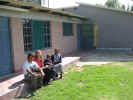 Our godson Milton is a true joy. At 5 ½ years old, he is curious and eager, his
huge brown eyes just shining with a zest for life. His dark brown straight hair
is cut short, with only an occasional stray lock creeping down to his smooth
brown forehead. He is extremely well-mannered, but his pure exhuberance for life
is always bubbling just underneath, and escaping constantly Milton thinks Marvin is the bee’s knees. When we walk through town, he
eagerly plants his hand into Marvin’s, and hops excitedly to keep pace with
him. He watches Marvin’s every move, and imitates his stance, his expressions
and gestures. He sits next to him at all opportunities. Marvin has never before
been so thoroughly worshipped and revered.
Our godson Milton is a true joy. At 5 ½ years old, he is curious and eager, his
huge brown eyes just shining with a zest for life. His dark brown straight hair
is cut short, with only an occasional stray lock creeping down to his smooth
brown forehead. He is extremely well-mannered, but his pure exhuberance for life
is always bubbling just underneath, and escaping constantly Milton thinks Marvin is the bee’s knees. When we walk through town, he
eagerly plants his hand into Marvin’s, and hops excitedly to keep pace with
him. He watches Marvin’s every move, and imitates his stance, his expressions
and gestures. He sits next to him at all opportunities. Marvin has never before
been so thoroughly worshipped and revered.
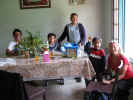 Our arrival present to Milton is a 1000-piece set of Legos, and Milton and his 9 ½
year old brother Rodrigo are immediately in builders’ heaven. They spread the
varied colored pieces on the tile floor of their living room, and soon there are
monsters and trucks and houses and robots everywhere.
Our arrival present to Milton is a 1000-piece set of Legos, and Milton and his 9 ½
year old brother Rodrigo are immediately in builders’ heaven. They spread the
varied colored pieces on the tile floor of their living room, and soon there are
monsters and trucks and houses and robots everywhere.
This time in Cochabamba, we spend more time with Felix and Isabel Cabrera,
and their sons Rodrigo and Milton. Our friendship and love and respect for this
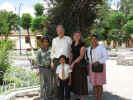 young couple, who are our compadres (co-parents to Milton), deepens
tremendously. They are so hard-working and honest and well-grounded. Both have a
wonderful, but different sense of humor. They are caring and devoted parents to
their two sons – genuinely the best of the good people.
young couple, who are our compadres (co-parents to Milton), deepens
tremendously. They are so hard-working and honest and well-grounded. Both have a
wonderful, but different sense of humor. They are caring and devoted parents to
their two sons – genuinely the best of the good people.
On lazy Sunday afternoons, we spend time with the in the city’s many parks, or time at Felix and Isabel’s home in the country. We talk about our families, the various projects we are working on. We talk about Milton’s schoolwork and his education, and we share our goals and dreams for the future. (Martie)
THE VILOMA SCHOOL
Nestled against the dusty foothills of the 16,900-foot mountain called Cerro Tunari, the small rural town of Viloma has no paved streets, and only occasional running water and electricity. The school buildings are crumbling and gloomy. One of the long, low buildings is a former cattle shed. There are simple, inadequate benches for students, but no blackboards, textbooks or teaching materials. No bus transportation is provided, so students must walk to school, and some from outlying farms have to walk for 2 hours one way.
The Bolivian government pays meager wages to its teachers, but provides no other funding for facilities or supplies in this country school of 500 students. And the villagers of Viloma are too poor to provide much additional funding, yet too proud and ambitious for their children to give up on the school. Amizade is helping them build 10 new classrooms, and the community of Viloma assists with what supplies and labor they can.
Our first work group at the school is small, but dynamic. Married couple Dan and Robin have no idea what they have signed up for on their maiden third-world adventure, but they are brave and open-minded and fun-loving enough to take it all in with gusto. Their partner in crime is Carl, a seasoned world traveler whose wit and fast-paced humor keep us constantly guffawing and slapping our thighs for the entire two weeks. Nothing is sacred with Carl – no moment too solemn, no human too proud, no circumstance too dire for a jovial, clever, hilarious observation on the state of the world. Dan and Robin and Carl bond instantly, and living and working with them is a zany and wonderful experience.
First, we have to give the 3 of them Spanish names – something our Bolivian friends and co-workers can pronounce. "Carl" is easily translated into "Carlos". But "Robin" we turn into "Pajarita" (that red-breasted harbinger of spring), and "Dan" starts out as "Daniel", but through one of his unnumerable, hilariously twisted misunderstandings of the language, becomes "Cuatro Man".
Pajarita and Cuatro Man learn the indubitably fine art of floor tiling, under
the careful tutelage of our head mason and dear compadre Felix. They begin on
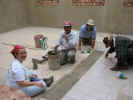 one of the 20 X 25 foot classrooms that already boasts cement walls and a plaster
ceiling. In the brown, arid landscape of Viloma, set in the foothills of
towering mountains, the dust swirls constantly through the school grounds. So,
every morning for Pajarita and Cuatro Man begins with a triple sweep of the work
area, fighting to rid the floor of a dust that is stubbornly determined to claim
its rightful home. The second tiling chore is to blend the cemento. This
seemingly simple job involves taking a large plastic bucket and stirring cement
and water into a smooth mixture with a long narrow stick. Lest this seem too
easy, imagine stirring 5 gallons of pancake batter in a large pail with the
handle end of a broomstick, UNTIL YOU GET ALL THE LUMPS OUT! The final set-up
job is lining up a string, set with 2 nails, to mark the perfectly straight line
along which each tile will be perfectly placed.
one of the 20 X 25 foot classrooms that already boasts cement walls and a plaster
ceiling. In the brown, arid landscape of Viloma, set in the foothills of
towering mountains, the dust swirls constantly through the school grounds. So,
every morning for Pajarita and Cuatro Man begins with a triple sweep of the work
area, fighting to rid the floor of a dust that is stubbornly determined to claim
its rightful home. The second tiling chore is to blend the cemento. This
seemingly simple job involves taking a large plastic bucket and stirring cement
and water into a smooth mixture with a long narrow stick. Lest this seem too
easy, imagine stirring 5 gallons of pancake batter in a large pail with the
handle end of a broomstick, UNTIL YOU GET ALL THE LUMPS OUT! The final set-up
job is lining up a string, set with 2 nails, to mark the perfectly straight line
along which each tile will be perfectly placed.
After about 45 minutes of preparation, the tiling can begin. On days one and two, Cuatro Man and Pajarita complete two or three rows of tile. By days 4 and 5, both have doubled their output, not to mention their "tiling confidence" level. Also by day 3, Cuatro Man is tying towels around his knees to lessen the impact of constant kneeling on his tender, aching body. During the weekend, we comb the La Cancha market in Cochabamba for kneepads, ultimately finding some fire-engine red ones that make a terrific fashion statement when pulled over dusty, cement-spotted jeans.
Meanwhile, Carlos and I are enthusiastically learning how to stucco the walls
in the classroom next door. Since all of the reachable walls have already been
stuccoed, our job involves climbing onto 10 foot-high scaffolding and working on
the upper walls and peaks to the roof. Old tires with wood planks
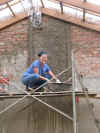 nailed to the bottom are our "buckets" of cement / pebble mix. Step one of
stuccoing involves one of the trickiest maneuvers I have yet encountered. If you
scoop up the cement mix on the back side of the trowel, hold the magic
trowel at exactly the perfect angle, then flick your wrist artfully at the
intended wall, the cement mix magically jumps from the trowel and sticks to the
wall. Sadly, I can never quite master this feat, and settle for a direct attack
on the wall, thus partially ensuring the cement hits its specific destination.
Carlos is better at this than I am, although neither of us ever reaches the
mastery of our supervisor, Juan. Since there is a villager assigned full-time to
scraping up the leftover cement blobs on the floor below me, and returning them
to my tire for re-use, we still don’t waste much cement in my ineptness.
Nevertheless, there is something soulfully satisfying about scooping up and
throwing muddy blobs, then smoothing them on the wall – kind of a cross
between finger-painting and sloshing in the mud as a kid.
nailed to the bottom are our "buckets" of cement / pebble mix. Step one of
stuccoing involves one of the trickiest maneuvers I have yet encountered. If you
scoop up the cement mix on the back side of the trowel, hold the magic
trowel at exactly the perfect angle, then flick your wrist artfully at the
intended wall, the cement mix magically jumps from the trowel and sticks to the
wall. Sadly, I can never quite master this feat, and settle for a direct attack
on the wall, thus partially ensuring the cement hits its specific destination.
Carlos is better at this than I am, although neither of us ever reaches the
mastery of our supervisor, Juan. Since there is a villager assigned full-time to
scraping up the leftover cement blobs on the floor below me, and returning them
to my tire for re-use, we still don’t waste much cement in my ineptness.
Nevertheless, there is something soulfully satisfying about scooping up and
throwing muddy blobs, then smoothing them on the wall – kind of a cross
between finger-painting and sloshing in the mud as a kid.
The next step is screeing. After completely covering a section of wall and smoothing it out, you take the regla (a long metal rod) and set it against the wall. Using hardened concrete "buttons" at either side, you press the regla against the wall, while moving it up and down the wall in a wavy, back-and-forth motion, scraping off excess cement in some areas, and exposing other areas of too little cement. Then you repeat the process of adding cement where needed with a trowel, then screeing with the regla until the surface is as level as possible.
Are we done now? Oh heavens, no! Because the cement we use is so course, containing up to marble-sized stones, (not to mention other stray objects such as straw, plaster and pieces of plastic) we now mix a very fine cement called fina. We apply it with a wooden float, using a kind of figure 8 motion to fill all the cracks, smooth out the bumps and bubbles, and create a defect-free surface. Lest that seem easy, imagine that pancake batter you were stirring earlier, and now spread it out in a 4-foot long puddle on the kitchen counter so that every square inch is exactly the same thickness.
The piece de resistance is smoothing even that smooth surface with, of all things, a block of styrofoam called plastiforma. By using small amounts of water and rubbing ever so gently with the plastiforma, the final effect is an almost glass-smooth surface to which paint can be applied directly.
Our teacher and maestro in the stuccoing is Juan, Felix’s older brother. His smile and his voice are like Felix’s, but he is more carefree, more joking, more "man-about-town". His stuccoing skills are superb. He can fix a giant-sized Martie boo-boo in seconds and make it look easy. He gives Carl and me maestro points when we achieve a certain degree of finesse; then smilingly takes them away again when we make an error too great to ignore.
Juan shoos away the curious and gawking school kids, as though we are great
artists whose masterpieces must not be viewed until the final brush stroke
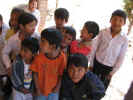
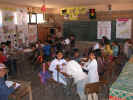 has been completed. But when we stop for breaks and lunch time, the kindergarten and
younger elementary kids gather around to study us anyway. They hover ever so
shyly, using posts and bushes for cover, as if to be prepared for an urgent
escape from the gringos. They barely answer our questions and attempts to
engage them in conversation, seemingly preferring to stare silently, with
occasional whispers and giggles to their schoolmates. We gringos are
apparently endlessly fascinating – we wear odd clothes, and eat weird foods,
and talk funny English – or worse yet, pronounce practically incomprehensible
Spanish.
has been completed. But when we stop for breaks and lunch time, the kindergarten and
younger elementary kids gather around to study us anyway. They hover ever so
shyly, using posts and bushes for cover, as if to be prepared for an urgent
escape from the gringos. They barely answer our questions and attempts to
engage them in conversation, seemingly preferring to stare silently, with
occasional whispers and giggles to their schoolmates. We gringos are
apparently endlessly fascinating – we wear odd clothes, and eat weird foods,
and talk funny English – or worse yet, pronounce practically incomprehensible
Spanish.
Cuatro Man is really good at talking to the older kids, even though his most expert Spanish phrase is "mucho bueno". But they find ways to point and use Spanglish and communicate, interspersed with lots of laughing and howls. Carlos falls in love with, and practically adopts 6-year-old Javier, a darling first-grader with the world’s widest smile. Away from the other kids, Carlos secretly shares food with Javier from his secret stash.
After lunch break we return to our building jobs. Stuccoing is messy and
grueling work. But high up on the scaffolding, with a clear view over the
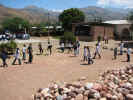 schoolyard to the towering mountains, the brilliant Bolivian sun warming me and the breeze
stirring playfully as I throw blobs of cement onto the wall, I think I am in
heaven. My tiredness comes with the euphoria of building not just a school, but
a future for a community that didn’t give up on their dream. These kids will
have their school someday.
schoolyard to the towering mountains, the brilliant Bolivian sun warming me and the breeze
stirring playfully as I throw blobs of cement onto the wall, I think I am in
heaven. My tiredness comes with the euphoria of building not just a school, but
a future for a community that didn’t give up on their dream. These kids will
have their school someday.
After 2 weeks of tiling and stuccoing, the school puts on a celebration to
thank us. Seated on harsh wooden benches, in the center of the dusty central
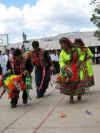
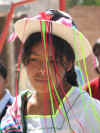 playgound area, we delight in the beautifully costumed high school students performing
native dances. A young boy reads a poem, and shy teenaged girls hang fresh
flower wreaths around our necks and "bless" us by rubbing
multi-colored confetti into our hair. There are thank you speeches from the
school officials; then I speak on behalf of our group. "Education is the
dream of every community and parent", I tell them. "We are honored to
be here and help you make this dream come true". And I stop there, electing
not to tell them how ashamed I am of my country, that it would choose to make
war instead of making opportunities for education, health and hope.
playgound area, we delight in the beautifully costumed high school students performing
native dances. A young boy reads a poem, and shy teenaged girls hang fresh
flower wreaths around our necks and "bless" us by rubbing
multi-colored confetti into our hair. There are thank you speeches from the
school officials; then I speak on behalf of our group. "Education is the
dream of every community and parent", I tell them. "We are honored to
be here and help you make this dream come true". And I stop there, electing
not to tell them how ashamed I am of my country, that it would choose to make
war instead of making opportunities for education, health and hope.
After two weeks, Carlos, Pajarita and Cuatro Man head back to the U.S., so touched and emotionally committed to this small community in Bolivia that they vow to recruit all their friends and come back as soon as they can. Vayan con Dios. We hope you will return soon.
Three weeks later, a new group arrives to work at Viloma. Stephen and Amanda are a married couple, veteran travelers and very conscious of third world issues. Billy and Tom (not travelling together) are both taking their first jaunt into the third world.
There is plenty of tiling on the floor of the second classroom that Pajarita
and Cuatro Man never got to, and the six of us switch on and off on that task.
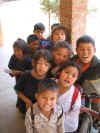 The new major project this time is pouring the concrete walkway in front of the
classrooms. Because the plaster and straw roof had been build the previous week,
the stone foundation of the walkway has suffered numerous bird-poop-like
droppings of hardened plaster. And since the plaster will not bond well with the
cement we will pour, it must be removed. For the better part of 4 days, I scrub
the offending rocks with a small wire brush. Billy and Stephen and Amanda all
scrub at various times, too. It is truly the most demeaning of tasks, but it
must be done, and I have flashbacks to Cinderella, who had to scrub her wicked
family’s floor. The major difference is that for me, there is no fairy
godmother, beautiful dress, or dreamy ball – just more white poop to scrub.
The new major project this time is pouring the concrete walkway in front of the
classrooms. Because the plaster and straw roof had been build the previous week,
the stone foundation of the walkway has suffered numerous bird-poop-like
droppings of hardened plaster. And since the plaster will not bond well with the
cement we will pour, it must be removed. For the better part of 4 days, I scrub
the offending rocks with a small wire brush. Billy and Stephen and Amanda all
scrub at various times, too. It is truly the most demeaning of tasks, but it
must be done, and I have flashbacks to Cinderella, who had to scrub her wicked
family’s floor. The major difference is that for me, there is no fairy
godmother, beautiful dress, or dreamy ball – just more white poop to scrub.
When we have finally cleaned and laid the forms for the walkway, the pouring and leveling of the cement goes very quickly. Juan shows us how to smooth the surface with the float, and to use an edger to create fine, smooth, rounded corners and joint lines. We do this for several days, adding about 20 feet of walkway per day. The U.S. volunteers are rudely interrupted one day when the pigs who live across the dirt road from the school are caught, tied down and castrated, and squeal in fear and agony. Our Bolivian comrades, however, work on with only a shake of their heads, and a half-smile at our distress.
Billy and Amanda and Stephen also spend time chipping out bricks and re-laying them in two doorways that are too narrow. Tom devotes himself almost entirely to tiling (except for his several days in sick bay). And on the last day of work, I have the privilege of a few hours of stucco work again on the third classroom. Yee-ha!
We have another closing ceremony after our two weeks of work. Again, there are hugs and flower wreaths and dancing and speeches. At the completion of two work sessions of two weeks each, we’ve tiled 2 classroom floors, rebuilt two doorways, poured 2/3 of the walkway, and stuccoed the walls of 1 ¾ classrooms. Two classrooms still lack both roof and floor. One has no stucco at all. We’ve accomplished so much, yet the children of Viloma will have to continue their classes in the cattle shed for some time to come. (Martie)
THE ORPHANAGE (EL HOGAR DE NINOS)
It is such a joy to return to the orphanage. Two years after our last time at the Hogar, there are many of the same children, but some new ones too. My shy, 8-year-old Ana is now a less-shy 10 years old, and has a best friend named Eden. They are giggly and secretive and have great fun together. Four-year-old – bright, inquisitive, rambunctious Juanito just arrived at the Hogar a week ago. And there is also a new family of two sisters and a brother – Jessica and Giovana, ages 4 and 6, and their brother Cristian, who is 8.
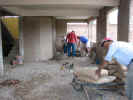 During the mornings, most of the children are down the road at the public school, and
just the 4 and 5-year-olds are around. One of our volunteers, Gwen, spends at
least an hour each day playing with the pre-schoolers. Even with almost no
knowledge of Spanish, she plays games with them, and uses bilingual flash cards
with the translation help of one of the older orphan girls. The kids love the
time she spends with them, and they clearly take to her attention and caring.
The second week we bring bubble-blowing supplies, and all of the children go
crazy laughing and chasing bubbles around the grounds.
During the mornings, most of the children are down the road at the public school, and
just the 4 and 5-year-olds are around. One of our volunteers, Gwen, spends at
least an hour each day playing with the pre-schoolers. Even with almost no
knowledge of Spanish, she plays games with them, and uses bilingual flash cards
with the translation help of one of the older orphan girls. The kids love the
time she spends with them, and they clearly take to her attention and caring.
The second week we bring bubble-blowing supplies, and all of the children go
crazy laughing and chasing bubbles around the grounds.
This time all the other volunteers are Elderhostelers: married couples Kay and Abe, and Karen and Neal; and singles Jim, Gwen and Gwen. They are from all over the U.S., as well as from various backgrounds and sets of travel experiences. Our major jobs are to complete the floor tiling on the first floor of the nuns’ residence, and to prepare for stuccoing on several of the walls.
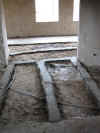 One of the Gwens and I are paired with Juan, and he somehow turns our work
into a friendly and joking competition with Felix, Marvin and Kay. Juan insists
our tiling team works faster and more accurately than Felix’s. We hoard tools
from each other’s teams, and peer across the room to measure each other’s
progress. Tiling is not hard work in and of itself, but being on your knees or
butt the entire day can add up to a lot of aches over the hours. And the stress
component is that the tiles must be perfectly placed, or Juan will come by and
tell you to remove them and start over. He has no shame
One of the Gwens and I are paired with Juan, and he somehow turns our work
into a friendly and joking competition with Felix, Marvin and Kay. Juan insists
our tiling team works faster and more accurately than Felix’s. We hoard tools
from each other’s teams, and peer across the room to measure each other’s
progress. Tiling is not hard work in and of itself, but being on your knees or
butt the entire day can add up to a lot of aches over the hours. And the stress
component is that the tiles must be perfectly placed, or Juan will come by and
tell you to remove them and start over. He has no shame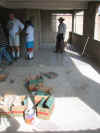 about doing so, and Gwen
and I must remove what seems like hundreds of tiles over the two weeks of work.
about doing so, and Gwen
and I must remove what seems like hundreds of tiles over the two weeks of work.
But Gwen and I are a good, hard-working team, and Juan encourages us by giving maestra points to our work. He assures me I have way more maestra points than my closest competitor, Marvin. We jump way ahead of Felix’s team on week two, when they lay 2 rows of tile before realizing that the color is slightly off, and they must take them all up. We learn how to put the lechero (grout) in the cracks, and also lay the baseboard tiles. I learn to hand-cut tiles, and also use the tile cutter to cut odd-shaped tiles for corners and doorways. By the end of our work session, my palms are bruised from tile-cutting, and my finger tips cracking and bleeding from all the cement exposure. But the first floor is completely tiled, and it looks beautiful.
On the last day, we have a big party – to celebrate the completion of our
work, and also Abe’s 80th birthday. The kids are treated to
hamburgers, french fries, and TWO cakes. This is an extra special occasion for
them. They get to congratulate Abe by rubbing confetti on his head, and all 35
orphans and the 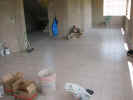 masons
do it with great gusto. It is a birthday Abe will always remember.
masons
do it with great gusto. It is a birthday Abe will always remember.
And then it is time to say goodbye to the kids. This is always an emotional time for me. Bolivian children use the terms Tio (uncle) and Tia (aunt) for adults who are not related, but who are somehow close or caring to them. And so my last visions of the beautiful faces of those orphans are always their bright eyes and smiles, and their high, clear voices calling "Ciao tio, ciao tia". It seems unfair to me to receive this much adulation for such small efforts on our part. I tell Ana and the others that I will return in 2 years, and that I will think about them every day. (Martie)
FELIX AND THE PUMP
When you wake up every morning, turn on the light, pad down to the bathroom, use the toilet, turn on the water and step into a hot shower, do you think much about it? Probably not. Remember how frustrated you were with the utilities folks during that last storm when the power didn’t come back on for TWO hours? Water, sewer and electricity can not be taken for granted in many countries, Bolivia included.
Our compadre Felix has been moving up in the world. When I first met him, he had the proverbial shack out back, and his wife Isabel did all cooking and washing in a dirt-floored shed. Then he put a toilet in the shack, but it required a bucket to flush. As his masonry business flourishes, he has built several rooms on to his brick and tile house. He has added a kitchen with sink WITH RUNNING WATER, and a bathroom complete with sink, toilet, urinal and shower. He should be able to develop a modern, middle class routine just like us, right? Wrong! Modern bathroom; ancient supply design. Streetside water passes the house in about a 2"0 line. Felix may attach his house to that with a ½" pipe. His street has water most mornings until around noon. The pressure is just enough to supply a trickling stream to the kitchen sink or bathroom basin. Sometimes there is just enough pressure for a shower, but when Felix comes home dirty from work in the early evening, the water is no longer being supplied.
Bolivians have a solution: they install a cistern or large tank at or below ground level. There is another tank on the roof. When the water is available, the cistern is filled and a pump takes water from the cistern up to the roof tank. Water is then available at a pressure dependent on the height of the roof tank and until the cistern is empty. Tanks and pumps cost money, something else in short supply.
Durolite is the name of a company that sells roofing panels. If you purchase your roof from Durolite, the company will give you a roof tank. Can you pass up a freebie? Well, neither can Bolivians. Without actually counting, I would say 50% of the houses in any given area have Durolite tanks on the roof. Oh, did I mention that each tank has a big blue Durolite logo on it, instantly readable and recognizable from the ground level? Who needs a Superbowl for grabbing market share?
So Felix had a roof tank, but no way to fill it, since the city water had insufficient pressure to reach the roof top. U.S. water comes into the home between 40 and 60 PSI. That means you can fill an upstairs bathtub about as quick as one downstairs, you get some sting if you adjust your shower just right, and your toilet fills before the next user shows up. A PSI of 14.7 equals 33 feet of water column so that Bolivian roof tanks need to be 8 stories high to get the pressure the U.S. enjoys. Felix’s roof tank is at best 8 feet over his shower head. Think gentle rain. This works in his favor, first, because many shower heads have an electrical heating coil (since hot water tanks are rare and expensive) which provides its hottest water at the lowest flow rate. Second, less water is used. Whereas a U.S. family of four will average 2000 gallons per day, Felix’s cistern and roof tank will hold about 400 gallons for his family of four.
Felix wanted my input on solving his water problem, and I wrestled with low tech, inexpensive approaches to getting water to that roof tank. I sure wanted to put a Nicaraguan rope pump into service in Bolivia, but never could figure out the details. At the end, we left Felix with a system diagram and bought the family a pump for Christmas. But Felix will have to save for a cistern and pipe. And I bet he will trade a little masonry for a little plumbing before he ultimately gets adequate pressure in his house. But, he is a long way from the rain barrels and creek water of his childhood. (Marvin)
FATIMA
During our 6 months’ stay in 2003, we worked part-time at CEOLI, the center for handicapped children and young adults. I have never spent time around disabled people, so being in this environment was a learning experience for me. In a way, I was like Gulliver – an able-bodied oddity in the land of the disabled. There are many preconceptions that fly out the window as you watch these kids having fun at recess – the mentally handicapped pushing the wheelchairs of the physically handicapped in some incomprehensible game that only ends when the wheelchair gets trapped by a physical constraint which is beyond the mental capability of the pusher to resolve; whereupon he or she walks off, basically stranding the kid in the wheelchair. It is not long before these folks have names and personalities. You get to know them as people.
Like all kids, they get sick, but unlike most kids, they may need operations and medications because of their disabilities – sometimes just to stay alive. CEOLI will never have enough money, so funds go first to save lives, next to sustain lives. Then the money is gone. So kids like Fatima will always have their handicaps.
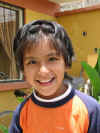 I don’t know how Fatima and I got to be buddies. Most likely she chose me. In
2003, she was seven, and in my Dad’s words, as cute as a speckled pup. As far
as we know, she is mentally and physically normal, except that she has a palate
deformity that makes normal speech impossible. In the U.S., she would have had
corrective surgery before she was two, regardless of her economic status, and
she would have grown up without being mute.
I don’t know how Fatima and I got to be buddies. Most likely she chose me. In
2003, she was seven, and in my Dad’s words, as cute as a speckled pup. As far
as we know, she is mentally and physically normal, except that she has a palate
deformity that makes normal speech impossible. In the U.S., she would have had
corrective surgery before she was two, regardless of her economic status, and
she would have grown up without being mute.
In the CEOLI triage there will never be funds for these kinds of problems. So, when I got back to the States in late 2003, one of my first orders of business was to explore how to get Fatima her corrective surgery. I admit I was naïve. I never thought it would be a simple 1-800-FATIMA. But neither did I think I would still be waiting for results even as I write this journal in early 2006.
Early in 2004 I contacted an ENT friend of mine, told him about Fatima, and told him I had some medical records. After some networking on his part, I was put in contact with a practicing medical professor at UCLA. Following emails, phone calls and records exchanges, the doctor arranged for necessary surgeries to be free of charge at a California medical center, but it was anticipated that Fatima would be in the U.S. for 6 months. The doctor put me in touch with the California branch of an organization called Healing the Children. By now, it was Thanksgiving of 2004
Healing the Children (HTC) provides transportation and home care for children world-wide who come to the U.S. for medical treatment. They have lots of paperwork to be filled out. For the next 6 months, I sent blanks to Cochabamba. In turn, the folks at CEOLI got Fatima’s mom to fill out the forms. They would fax a set to California, and only later would I find out the papers were not received. We did this twice. I could never get anyone in Cochabamba to mail me a copy, and believe me – there was more than enough time for snail mail to best any other method. I never did learn what happened to the faxes. But by June 2005, HTC was suddenly inundated with victims of the Dec. 26, 2004 tsunami in Thailand and Indonesia. HTC quickly became overloaded, and ground to a halt. Poor Fatima, who had been at the top of the list, dropped clear off the chart.
Soon after this disaster came news that HTC had just opened a new chapter in St. Louis, MO. After I got in contact with HTC, Missouri, things started to happen in weeks. These folks, although willing to bring Fatima to St. Louis, recommended a U.S.-trained ENT in Santa Cruz, Bolivia. We got our act together in the 2 ½ months Martie and I were in Bolivia. I can’t say enough wonderful things about HTC-St. Louis and their director.
During our stay in Cochabamba, we made all the arrangements for Fatima and her mother to fly to Santa Cruz for Fatima’s first surgery – removal of tonsils and adenoids. Fatima returned from that in mid-November, before we left for the U.S. We gave CEOLI money for Fatima to return to Santa Cruz in January 2006 for the reconstructive surgery. So the good news is – after 2 ½ years, Fatima is on the verge of being physically able to speak. (Marvin)
OUR NEW CAMERA AND PRINTER
The traditionalist photographer in me has resisted the move to an electronic camera for at least a dozen years. There were many reasons: the technology was not there yet; film had more detail, more "real" characteristics, Kodak needed all the help they could get – whatever. Meanwhile, I was getting my film developed at Seattle Film Works because they would electronically archive my prints. I love logical thinking.
Before leaving this time for Bolivia, I made the transition, not all the way to pro digital equipment, mind you, but further than the shirt pocket point and shoot. We "needed" electronic so we could share the results real time, and provide pictures to folks who otherwise might never have a photograph of themselves.
It was a hoot to shop the electronic sections. First, we learned that if you were born before, say 1985, you could not work there. Second, we showed up wanting a camera and printer that was small and packable, would take excellent pictures and be reliable and usable well off the beaten path:
Us: "So what do you do when the batteries run down?"
Sales dude: "Plug in the charger."
Us: "But what if there is no electricity?"
Sales dude: " We have a converter you can plug into the car’s lighter."
Us: "But we won’t have a car."
Sales dude: (Extremely long pause - speechless and open mouthed, while processing the existence of such a place on his planet.) "Oh."
We ended buying a Canon S2 lS and an HP385 printer which, using the optional battery, prints about 75 4 X 6 prints per charge. The printer is about 4" X 4" X 10", weighs less than 5 lbs. and prints with stunning detail. As my compadre Felix says, "Marvin’s camera and printer don’t make any mistakes." Admittedly all of the equipment relies on rechargeable batteries. They both work long hours before shut down and certainly in Bolivia we were able to recharge at will. An inexpensive transformer (converter) solved the 220V to 110V problem. (Most U.S. configured electrical equipment when plugged directly into a Bolivian socket will be smoking in less time than it has taken you to read this sentence.)
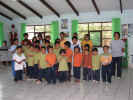 The point of all this preamble is to now relate how much fun it was to use in
the field. Our first experience was at Felix’s house. We took some pictures
and showed the results on the camera screen. When we learned that they would
like a copy of this or that, we whipped out the printer and poof! But the best
time was had at the orphanage. Some of these kids had not even seen themselves
in a mirror. We decided to take and print a picture of each child individually
for them to keep. So we lined everybody up and posed each in front of a neutral
background. Some were interested in checking out the camera screen, but this was
a known science, kind of blasé. Then I started printing. Suddenly the printer
and I were in a human igloo. Kids were hanging off other kids to get a look at
this machine. The white paper went in one side and then, millimeter by
millimeter, out came their photo. Nobody left this pile of humanity until his or
her picture was handed to them. I didn’t breathe fresh air or have 20 kids off
my back for over half an hour.
The point of all this preamble is to now relate how much fun it was to use in
the field. Our first experience was at Felix’s house. We took some pictures
and showed the results on the camera screen. When we learned that they would
like a copy of this or that, we whipped out the printer and poof! But the best
time was had at the orphanage. Some of these kids had not even seen themselves
in a mirror. We decided to take and print a picture of each child individually
for them to keep. So we lined everybody up and posed each in front of a neutral
background. Some were interested in checking out the camera screen, but this was
a known science, kind of blasé. Then I started printing. Suddenly the printer
and I were in a human igloo. Kids were hanging off other kids to get a look at
this machine. The white paper went in one side and then, millimeter by
millimeter, out came their photo. Nobody left this pile of humanity until his or
her picture was handed to them. I didn’t breathe fresh air or have 20 kids off
my back for over half an hour.
Martie reported seeing 4-year-old Juanito standing by himself, repeatedly pointing at a spot on the picture and then looking and touching that spot on himself, as if to verify every detail on the photo. That was a magic moment. So I will shoot and print, shoot and print, and maybe we will have some more magic moments. (Marvin)
LEAVING COCHABAMBA
In only a few short months, it is time to leave Cochabamba. But there are many people and projects that will bind us to this place until we return again. We will follow up on Fatima’s second surgery, work hard to sell many more CEOLI cards to support more handicapped artists, keep in touch with Felix and Isabel and our godson Milton and make sure his education is going well, see that our donation for books at the Viloma school is well-used, search for Spanish educational videos for use at the Hogar. We will honor the work being done there by our constant remembrance and support of the staff at CEOLI, the CEOLI artists, the villagers of Viloma, the nuns and orphans at the Hogar, and the many Bolivian people who are striving to overcome terrific obstacles. The possibilities for making a difference are astounding. And it only takes one act at a time.
The plane rises over the golden, dusty bowl that is the valley of Cochabamba, and soars to the distant mountains. Our bodies are seated comfortably in the fast-disappearing plane, but part of our hearts will always remain here in our Bolivian second home. (Martie)
